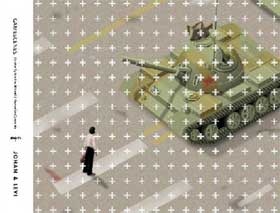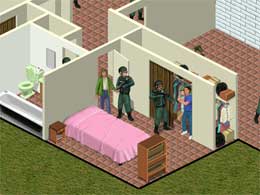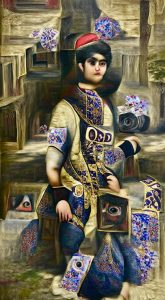 Gamescenes – Art in the Age of Videogames. Edited by Berkeley researcher Matteo Bittanti and curator and art critic Domenico Quaranta, Johan & Levi Editore, October 2006.
Gamescenes – Art in the Age of Videogames. Edited by Berkeley researcher Matteo Bittanti and curator and art critic Domenico Quaranta, Johan & Levi Editore, October 2006.
Editor’s blurb: GameScenes. Art in the Age of Videogames explores the rapidly expanding world of Game Art in the works of over 30 international artists. Included are several milestones in this field, as well as some lesser known works. In addition to the editors’ critical texts, the book contains contributions from a variety of international scholars that illustrate, explain, and contextualize the various artifacts.
This is one of the most educational (just remove any negative connotation that might be associated with that adjective), stimulating, and fun book you might find on the subject. So what about the subject? The introduction, by Bittanti, features a series of disclaimers. The book is not about “Videogames as art”, nor “Art as game”, nor game art, it’s not about Art Games either. It is about Game Art. If you find these different terms confusing, you’re certainly not the only one, that’s why the author explains very clearly what distinguishes one area from the others. He defines Game Art as “any art in which video games played a significant role in the creation, production, and/or display of the artwork. The resulting work can exist as a game, painting, photograph, sound, animation, video, performance or gallery installation.”
Quaranta and Bittanti have asked a bunch of smart people (Rebecca Cannon , Henry Lowood, Maia Engeli, Valentina Tanni, etc.) to write a couple of witty pages or more about 32 Game Artists (or Game Art groups) and their work. They range from the usual and bright suspects such as JODI, Miltos Manetas, Brody Condon, Cory Arcangel, Eddo Stern, Margarete Jahrmann and Max Moswitzer to talents who have emerged over the past couple of years like Aram Bartholl, Alison Mealey, etc.
The result is a wonderful little exhibition on paper (which in fact echoes a real exhibition held in Monza a couple of months ago): the curators are passionate, they know their subject, and gave the images of each work the space they deserve, visitors will very probably discover new pieces and/or be happy to find that some of their favourite ones have not been left out, etc. As the authors themselves admit, they could only select a tiny fraction of what makes Game Art today but that’s enough to get a good idea of how multi-faceted, exciting and sophisticated the field has grown to be.
The book closes with an essay by Quaranta: “Game Aesthetics – How video Games Are Transforming Contemporary Art” looks at how this twitching of codes, symbols, themes and representations by videogame artists is conditioning the aesthetics and registers of other media.
I still have to go through all the essays on artists, i’m taking my time, enjoying the pages bit by bit. Next week or so i’ll probably share with you some of the discoveries i made through this book, but i won’t blog them all, i’d rather let you dig up the rest in Gamescenes.
Bonus 1: A glossary. Bonus 2: at the end of the volume, there’s a translation of the essays in italian.
Images are some of Jon Haddock’s Screenshots. The drawings are made from an isometric perspective, in the style of a computer game. The subject of each drawing is the image, or images, that created a popular cultural event. Historical events (like the assassination of Dr. Martin Luther King Jr. at the Lorraine Motel) are used interchangeably with fictionalized events (like the picnic scene from The Sound of Music).







